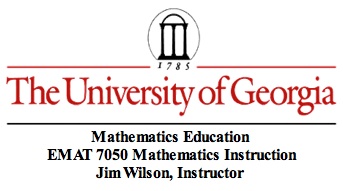
by
Jim Wilson
The imagined classroom situation we discussed was a regular 8th grade mathematics course when one of the students said, "I know that a negative number times a negative number will be positive and I can follow the rule and do calculations. I do not understand WHY the product is positive." The challenge was to consider a range of mathematical explanations or demonstrations to address the "Why?" rather than just the "How?"
Teachers have encountered this sort of question from students struggling to understand the use of signed numbers. There are several issues.
What can make sense to a student?
What are some mathematical explanations?
Can context (an application) be a vehicle for explantation?
How can instruction or activities be organized to help students understand "Why?" How can we know they understand?
In this site, I will address only the issue of mathematical explanations/demonstrations. The other questions may be more challenging.
Some Mathematics Explanations or Demonstations
Examine numerical patterns -- inductive approach
Use of number properties such as additive inverse and distribution of multiplication over addition -- deductive approach
Formal proof using number properties
Use of a number line model. There are several versions of this.
Use of applications
Money -- debt is negative, saving is positive
Use of time -- in the past negative, future positive -- usually in terms of spending or movement
Movement forward and backward along a road or path
Movie of a glass being filled with water and then emptied. Running backward is negative, emptying is negative; running
backward while emptying will show the glass filling: positive.Reduce the problem to (-1)(-1) = 1
Indirect proof. Assume the product is either 1 or - 1. If it is -1 then (-1)(1) + (-1)(-1) = -2 when it should be 0.
Interpretation of multiplication as repeated addition.
Use of the additive inverse.
Reflection in the number line.
Use of Cartesian Coordinate system and/or Pythatorean.
Use of area models
Use of numeration system and area model
Note: Some version of each of these and other can be found on line with a Google Search. Missing, however, is any analysis of strengths and weaknesses of any explanation. For instance, most of these embed two different meanings of the minus sign -- usually with no specific attention to those uses.
An alternative: Geometric model using directed lines and similar triangles.
Consider two lines that cross and indicate 0 as the common point. From the definition of a negative number as the opposite or additive inverse of a positive number, let each line have locations in the positive and negative directions. From the multiplicative identity, 1, indicate a unit in each direction on each line.
Any point on either line has an orientation, positive or negative, determined by a location.
Positive times a Positive
Let us begin by considering a positive value of a on the horizontal line and a positive value of b on the slant line.
Now construct a line segment from 1 on the horizontal line to b on the slant line. Construct a parallel line segment from a on the horizontal lie to its intersection with the slant line. From the geometry of similar triangles, we know that the location of the intersection is the product ab. See the image below.
This is also the classic construction of the fourth proportion -- 1 : b = a : x leads to x = ab
Because the triangles are similar, the location of the intersection represents the product of a and b. In this case we have show that the product of two positive numbers is positive.
Negative Times a Positive.
Next let’s consider the construction we have just done above but begin with a located in the negative direction and b located in the positive direction.
The construction is done in the same way, with a on the horizontal, b on the slant line, and construction of the segments from the 1 location to the b location and then a parallel segment from the a location to the intersection point. Again the intersection point will be the product ab but now this product is located in the negative direction. So (-a)(+b) = - ab.Again this is a direct consequence of the similar triangles.
Positive Times a Negative
Next let’s consider the construction we have just done above but begin with a located in the positive direction and b located in the negative direction.
The construction is done in the same way, with a on the horizontal, b on the slant line, and construction of the segments from the 1 location to the b location and then a parallel segment from the a location to the intersection point. Again the intersection point will be the product ab and again this product is located in the negative direction. So (+a)(-b) = - ab.
Negative Times a Negative
Now we are ready to move on to the case of the product of two negative numbers. Again let’s consider the construction we have been doing above but begin with a located in the negative direction AND b located in the negative direction.
The construction is done in the same way, with a on the horizontal, b on the slant line, and construction of the segments from the 1 location to the b location and then a parallel segment from the a location to the intersection point. Again the intersection point will be the product ab but this product is located in the positive direction. So (-a)(-b) = ab.
Here is a Geometer's sketchpad file with the above constructions. You can also drag a or b along their respective lines to see the combinations (++, -+, +-, --) transition from one to the other.